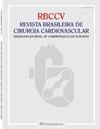d -二聚体和INR在疑似人工瓣膜功能障碍患者中的诊断价值
IF 1.1
4区 医学
Q4 CARDIAC & CARDIOVASCULAR SYSTEMS
Revista Brasileira De Cirurgia Cardiovascular
Pub Date : 2022-03-03
DOI:10.21470/1678-9741-2021-0230
引用次数: 0
摘要
引言人工瓣膜功能障碍是心脏瓣膜置换术的潜在关键并发症。需要一种简单、快速适用的诊断程序来识别人工瓣膜功能障碍。本研究的目的是前瞻性地确定D-二聚体和INR水平在预测人工瓣膜功能障碍中的诊断价值。方法对伊朗克尔曼沙省克尔曼沙医学科学大学附属伊玛目阿里医院收治的70名疑似人工瓣膜功能障碍的患者进行横断面研究。电影透视作为金标准诊断测试,用于诊断入选患者的人工瓣膜功能障碍。将每位患者的两毫升血液放入装有柠檬酸钠抗凝剂的试管中。为了评估D-二聚体,将截止值设定为500 ng/ml。此外,为了评估国际标准化比率(INR),将截止值设置为2。血清标志物的敏感性、特异性、阳性预测值(PPV)、阴性预测值(NPV)、阳性似然比(PLR)和阴性似然比(NLR)用于描述预测特性。结果70例患者中,男性27例(38.6%),女性43例(61.4%),平均年龄54.67±15.11岁(18~80岁)。在70名患者中,27名(38.6%)患者的人工心脏瓣膜功能异常可通过荧光镜检查证明,19名患者(27.1%)的D-二聚体水平>500 ng/ml。D-二聚体水平升高(>500 ng/ml)的敏感性为70.4%,因此NPV为84.3%,特异性为100%,PPV为100%,NLR为0.3,PLR为预测人工瓣膜功能障碍的无穷大值。荧光镜检查和D-二聚体检测之间存在显著关系(P=0.001)。κ系数值为0.745表明D-二聚物和荧光镜检查之间存在显著一致性。混合试验(D-二聚体和INR的组合)显示具有100%的敏感性,因此预测人工瓣膜功能障碍的NPV为69.8%,特异性为69.8%、PPV为51.8%、NLR为1.41和PLR为1.44。结论D-二聚体具有中等敏感性和高特异性,是诊断可疑患者人工瓣膜功能障碍的理想标志物。血浆D-二聚体水平升高本身并不能诊断人工瓣膜功能障碍,但可能会提醒医生推荐患者进行更详细的检查,最好是通过荧光镜检查。100%灵敏度的混合测试可以作为排除测试。本文章由计算机程序翻译,如有差异,请以英文原文为准。
Diagnostic Value of D-Dimer and INR in Patients Suspected to Have Prosthetic Valve Dysfunction
Introduction Prosthetic valve dysfunction is a potentially critical complication of heart valve replacement. An easy and quickly applicable diagnostic procedure is required for recognizing the prosthetic valve dysfunction. The purpose of this study was to prospectively define the diagnostic value of D-dimer and INR level in predicting prosthetic valve dysfunction. Methods This cross-sectional study was performed in 70 patients suspected to have prosthetic valve dysfunction admitted to Imam Ali Hospital, affiliated with Kermanshah University of Medical Sciences (KUMS), Kermanshah Province, Iran. Cinefluoroscopy, as the gold standard diagnostic test, was used for the diagnosis of prosthetic valve dysfunction in enrolled patients. Two milliliters of blood from each patient were taken into a tube containing sodium citrate anticoagulant. To evaluate D-dimer, the cutoff value was set at 500 ng/ml. Also, to evaluate international normalized ratio (INR), the cutoff value was set at 2. Sensitivity, specificity, positive predictive value (PPV), negative predictive value (NPV), positive likelihood ratio (PLR), and negative likelihood ratio (NLR) of the serum markers were used to describe predictive properties. Results Of 70 patients, 27 (38.6%) were male and 43 (61.4%) were female, and the mean age was 54.67±15.11 years (range, 18 to 80 years). Of 70 patients, 27 (38.6%) had prosthetic heart valve malfunction demonstrable by fluoroscopy, and 19 patients (27.1%) had D-dimer levels >500 ng/ml. Elevated D-dimer levels (>500 ng/ml) have been indicated to have sensitivity of 70.4%, and hence an NPV of 84.3%, specificity of 100%, PPV of 100%, NLR of 0.3, and the infinity value of PLR for predicting prosthetic valve dysfunction. There was a significant relationship between fluoroscopy and D-dimer test (P=0.001). A kappa coefficient value of 0.745 indicated a substantial agreement between D-dimer and fluoroscopy testing. Mixing test (combination of D-dimer and INR) showed to have 100% sensitivity, and hence a NPV of 69.8%, specificity of 69.8%, PPV of 51.8%, NLR of 1.41, and PLR of 1.44 for predicting prosthetic valve dysfunction. Conclusion D-dimer with moderate sensitivity and high specificity is an ideal marker for the diagnosis of prosthetic valve dysfunction in suspected patients. Enhanced plasma D-dimer level is not by itself diagnostic of a prosthetic valve dysfunction but may alert physicians to refer the patient for more detailed examination, preferably by fluoroscopy. Mixing test with 100% sensitivity can apply as a rule-out test.
求助全文
通过发布文献求助,成功后即可免费获取论文全文。
去求助
来源期刊

Revista Brasileira De Cirurgia Cardiovascular
CARDIAC & CARDIOVASCULAR SYSTEMS-SURGERY
CiteScore
2.10
自引率
0.00%
发文量
176
审稿时长
20 weeks
期刊介绍:
Brazilian Journal of Cardiovascular Surgery (BJCVS) is the official journal of the Brazilian Society of Cardiovascular Surgery (SBCCV). BJCVS is a bimonthly, peer-reviewed scientific journal, with regular circulation since 1986.
BJCVS aims to record the scientific and innovation production in cardiovascular surgery and promote study, improvement and professional updating in the specialty. It has significant impact on cardiovascular surgery practice and related areas.
 求助内容:
求助内容: 应助结果提醒方式:
应助结果提醒方式:


